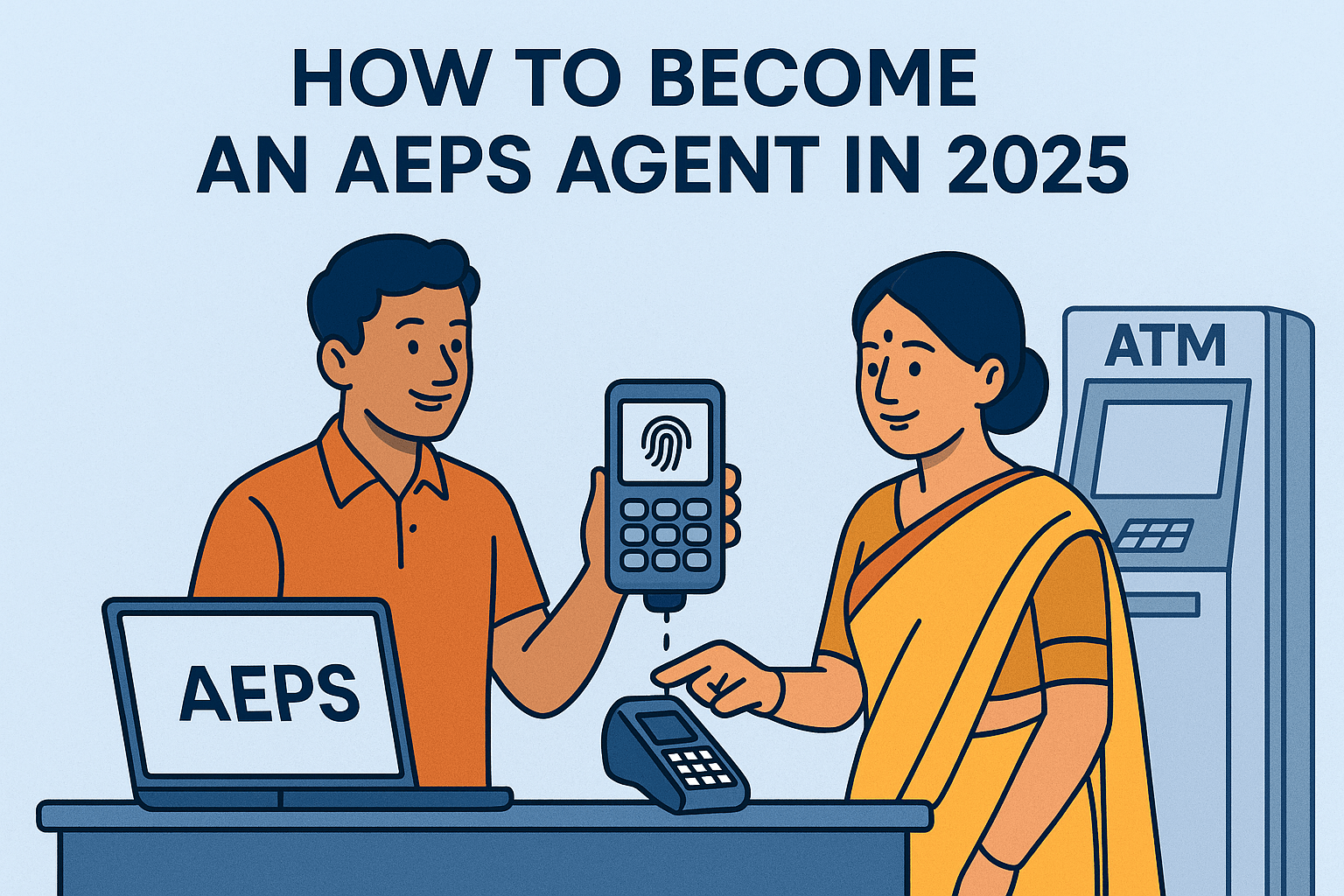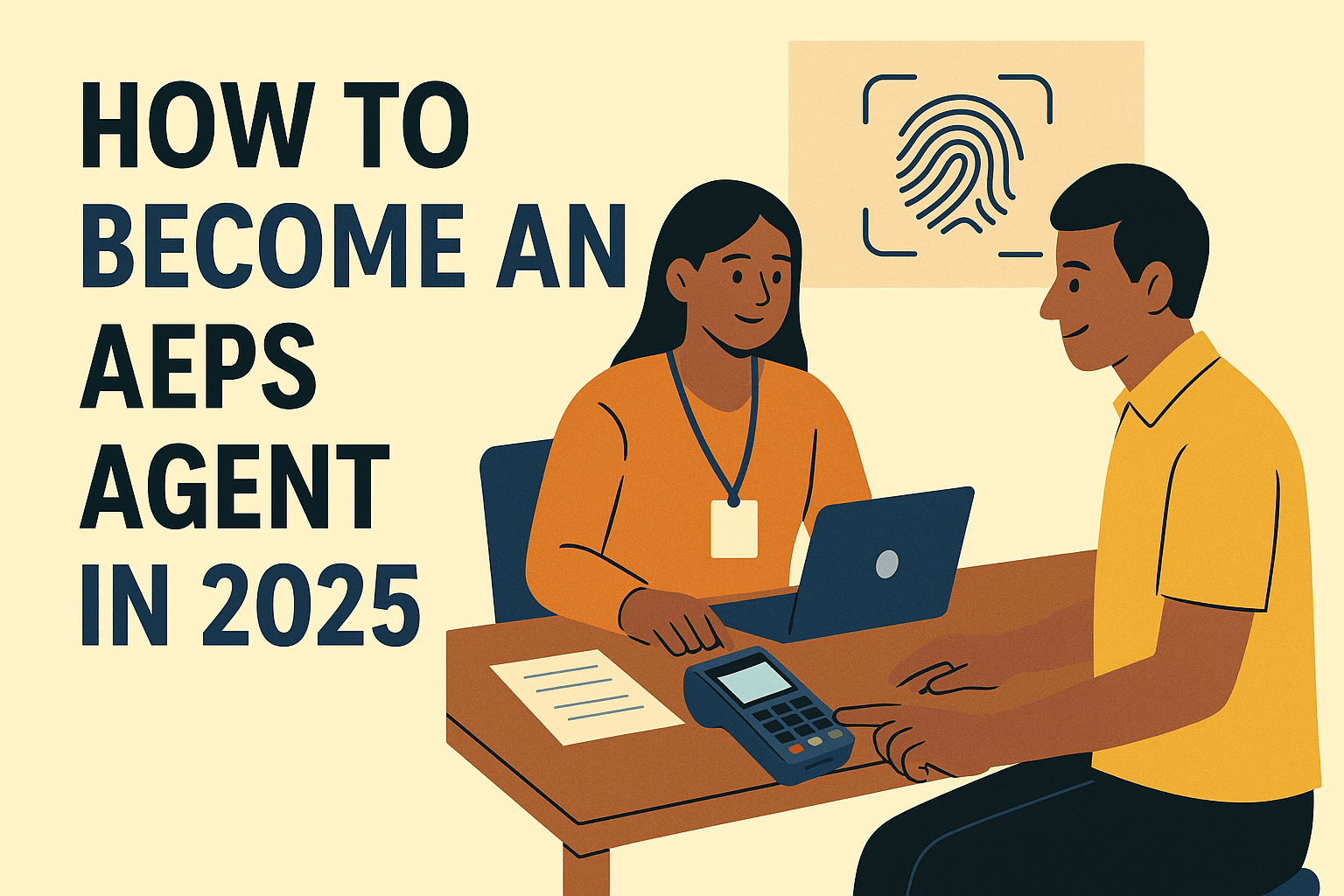In an era where digital payments are king, millions in (How to Become an AEPS Agent) India still rely heavily on cash for their daily lives. This gap between a digital economy and a cash-based society creates a powerful opportunity. This is where the AEPS agent comes in—a crucial financial touchpoint in villages and cities alike. If you’re looking for a low-investment, high-impact business model in the fintech space, you’re in the right place. This comprehensive guide will walk you through everything you need to know about how to become an AEPS agent in 2025.
Think of an AEPS agent as a human ATM. Through a simple biometric machine, you can help people withdraw cash, deposit money, check their bank balance, and transfer funds—all without them needing a debit card or complex digital literacy. All they need is their Aadhaar number and their fingerprint. It’s a business that serves a critical need and generates a steady commission for you.
What Exactly is AEPS?
Before we dive into the “how,” let’s quickly understand the “what.” AEPS stands for Aadhaar Enabled Payment System. It’s a bank-led model introduced by the National Payments Corporation of India (NPCI) that allows you to perform basic banking transactions by authenticating yourself with your Aadhaar number and biometric data (fingerprint/iris scan).
The system eliminates the need for physical cards, PINs, and signatures. For an agent, this means you can offer banking services to customers of any bank that is AEPS-enabled (which is virtually all major banks in India) through a single device.
Why Become an AEPS Agent in 2025? The Opportunity
The numbers speak for themselves. As of 2024, over 1.3 billion Aadhaar cards have been issued. The AEPS network processes hundreds of millions of transactions monthly, a number that continues to grow.
-
Recurring Revenue: You earn a small commission (typically ₹15-₹35) on every transaction. A high-footfall location can easily generate 50-100 transactions a day, leading to a healthy monthly income.
-
Low Investment: Compared to other brick-and-mortar businesses, the startup cost is minimal—primarily the cost of the biometric device and a smartphone.
-
Build a Customer Base: As an AEPS agent, you become a trusted financial service point. This trust allows you to later cross-sell other products like insurance, loans, or bill payment services, significantly boosting your earnings.
-
Work Flexibility: You can run this business from a small shop, your home, or even as a mobile service. The barriers to entry are incredibly low.

The New Process to Become an AEPS Agent in 2025: A Step-by-Step Plan
The core process hasn’t changed drastically, but the players and technology have evolved. Here’s the new, streamlined process for 2025.
Step 1: Check Eligibility Criteria
You don’t need to be a college graduate to start. The basic requirements are simple:
-
You must be at least 18 years old.
-
You must have a valid PAN card.
-
You must have an Aadhaar card linked with your mobile number.
-
You should have a bank account in your name.
-
No major criminal record.
Step 2: Choose Your Banking Partner (The Most Crucial Step)
You cannot directly become an AEPS agent with NPCI. You must partner with a bank or a registered fintech company that acts as a Corporate Business Correspondent (BC) or a Service Provider.
-
Option A: Partner directly with a Bank: Some banks like IDFC First, Bandhan Bank, and others have direct BC programs. This can be more rigorous and might require a higher security deposit.
-
Option B: Partner with a Fintech Company (The Popular Choice in 2025): This is the most common and hassle-free route. Companies like PayNearby, Bankit, Eko, and Easebuzz have simplified the onboarding process. They provide the technology, app support, and backend settlement seamlessly.
Pro Tip for 2025: Research fintech partners thoroughly. Look for:
-
Transaction Commission Rates: Compare what different companies offer.
-
Device Cost & Security Deposit: Some provide devices for free with a refundable deposit, others sell them.
-
Settlement Time: How quickly is your commission credited to your bank account? Look for daily or next-day settlement.
-
Additional Services: Can you also offer DTH recharge, bill payments, or insurance through their platform? This is key to future growth.
Step 3: Submit Your Application & KYC
Once you choose a partner, you’ll need to fill out an application form. This can often be done online through their website or app. You will need to provide:
-
PAN Card details
-
Aadhaar Card details
-
Bank account details
-
A passport-sized photograph
-
Your business address proof
The partner will perform a soft KYC check using your Aadhaar and PAN details. This process is now almost entirely digital.
Step 4: procure the Necessary Equipment
The primary hardware you need is a biometric fingerprint scanner. The most common models used in 2025 are from manufacturers like Mantra, Mswipe, or Eko. You can either:
-
Buy it outright from your service provider or a certified dealer (Cost: ₹2,000 – ₹6,000).
-
Get it with a security deposit which is often refundable after a certain period or number of transactions.
You will also need an Android smartphone with a stable internet connection (via SIM data or WiFi) to run the agent’s app provided by your banking/fintech partner.
Step 5: Onboarding & Training
Your service provider will grant you access to their agent mobile application or web portal. They will provide you with a unique Agent ID. Most companies offer digital tutorials and video guides on how to use the app and perform transactions. The interface is designed to be extremely simple.
Step 6: Start Your Operations
You are now ready to go! Set up your spot, put up a board (often provided by your partner), and start offering services. Promote your new business by word-of-mouth in your locality.
How Much Does It Cost to Start?
The investment is very affordable. Here’s a rough breakup for 2025:
-
Biometric Device: ₹2,000 – ₹6,000 (one-time cost)
-
Smartphone: If you don’t have one, a basic Android phone starts at ₹6,000. (This can be considered a one-time cost)
-
Security Deposit: Some companies may require a refundable deposit ranging from ₹1,000 to ₹10,000.
-
Initial Load Balance: You need a small float amount (e.g., ₹2000-₹5000) in your agent wallet to facilitate cash withdrawals for customers. This isn’t a cost but a working capital requirement.
Total initial investment can be as low as ₹3,000 to ₹15,000.

How Much Can You Earn?
Your income is 100% commission-based. A standard commission structure looks like this:
-
Cash Withdrawal: ₹ 15 – ₹ 25 per transaction
-
Cash Deposit: ₹ 15 – ₹ 25 per transaction
-
Balance Inquiry: ₹ 5 – ₹ 10 per transaction
-
Fund Transfer: ₹ 5 – ₹ 15 per transaction
Let’s do the math: If you handle just 20 cash withdrawal transactions a day at ₹20/transaction, that’s ₹400/day or ₹12,000/month. Add another 10 balance inquiries at ₹5 each (₹150/month), and your core AEPS income is ₹12,150. Now, imagine also selling insurance or recharges—your earnings potential multiplies.
Challenges and How to Overcome Them
-
Internet Connectivity: A stable internet connection is vital. Consider having a backup Jio or Airtel SIM.
-
Technical Glitches: Sometimes, the NPCI server or bank server might be down. Patience is key. A good service provider will have a responsive support helpline.
-
Biometric Authentication Failures: worn-out fingerprints, especially of laborers, can sometimes fail. Keeping a slightly wet cloth handy to clean the finger and the scanner can often solve this.
Conclusion: Is This the Right Business for You?
Becoming an AEPS agent is one of the most straightforward ways to tap into India’s booming fintech revolution. It requires minimal investment, offers quick returns, and provides a valuable service to your community. The process in 2025 is more digital and streamlined than ever before, largely thanks to fintech partners.
If you are a people person, have a strategic location (or can create footfall), and are looking for a stable secondary income or a primary business you can scale, this is an excellent opportunity. Do your research, choose your partner wisely, and you can build a successful and sustainable business as a micro-ATM provider.
Frequently Asked Questions (FAQs)
1. Do I need a shop to become an AEPS agent?
No, you do not necessarily need a physical shop. You can operate from your home, a kiosk, or even as a mobile agent visiting different areas. However, a location with high footfall (like a grocery store, pharmacy, or bus stand) will significantly increase your number of transactions.
2. Which is the best bank or company to partner with?
There is no single “best” company. It depends on your location and their network. Popular and reliable names in 2025 include PayNearby, Bankit, Eko, and Spice Money. Compare their commission rates, device costs, and support quality before choosing.
3. What if a transaction fails but the customer’s money is debited?
This is a common concern. In case of a failed transaction, the amount is automatically reversed by the bank and credited back to the customer’s account within 3-7 working days. Your service provider’s helpline can help track such transactions. Always provide a transaction receipt to the customer for reference.
4. Is this business safe and legal?
Absolutely. The AEPS system is mandated and regulated by the NPCI and the Reserve Bank of India (RBI). All transactions are secured through Aadhaar-based biometric authentication, making them very secure.
5. Can I offer AEPS services without a biometric machine?
No, a biometric fingerprint scanner is mandatory to authenticate customers via their Aadhaar data. It is the core hardware of this business.
Disclaimer: This article is for educational and informational purposes only. The information presented is based on research and industry practices as of 2025. The specific processes, costs, and commission structures may vary depending on the bank or fintech service provider you choose. We do not endorse any specific company. It is advised that you conduct your own due diligence and directly contact potential partners to verify the latest terms and conditions before making any financial commitment. If you have any concerns about the content of this post, please visit our DMCA page and follow the outlined guide for content removal requests.
